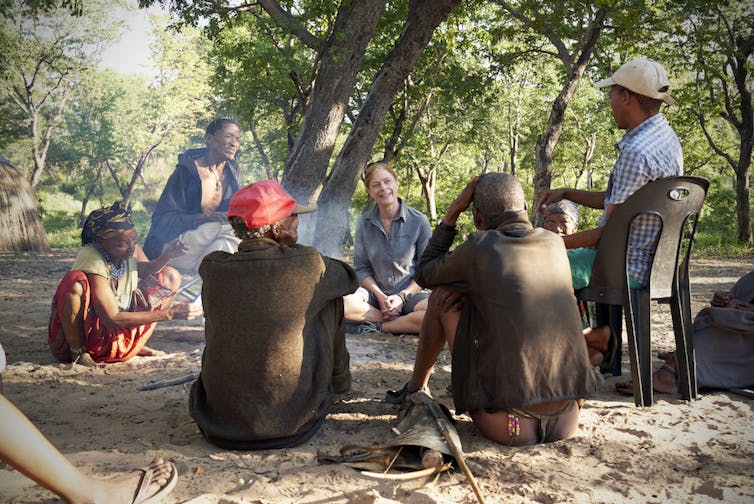A recent paper in the prestigious journal Nature claims to show that modern humans originated about 200,000 years ago in the region around northern Botswana. For a scientist like myself who studies human origins, this is exciting news. If correct, this paper would suggest that we finally know where our species comes from.
But there are actually several reasons why I and some of my colleagues are not entirely convinced. In fact, there’s good reason to believe that our species doesn’t even have a single origin.
The scientists behind the new research studied genetic data from many individuals from the KhoeSan peoples of southern Africa, who are thought to live where their ancestors have lived for hundreds of thousands of years. The researchers used their new data together with existing information about people all around the world (including other areas traditionally associated with the origins of humankind) to reconstruct in detail the branching of the human family tree.
We can think of the earliest group of humans as the base of the tree with a specific set of genetic data – a gene pool. Each different sub-group that branched off and migrated away from humanity’s original “homeland” took a subset of the genes in that gene pool with them. But most people, and so the vast majority of those genes, remained behind. This means people alive today with different subsets of our species’ genes can be grouped on different branches of the human family tree.
Groups of people with the most diverse genomes are likely to be the ones that descended directly from the original group at the base of the tree, rather than one of the small sub-groups that split from it. In this case, the researchers identified one of the groups of KhoeSan people from around northern Botswana as the very bottom of the trunk, using geographical and archaeological data to back up their conclusion.

If you compare this process to creating your own family tree, it makes sense to think you can use information about who lives where today and how everyone relates to each other to reconstruct where the family came from. For example, many of my relatives live on the lovely Channel Island of Alderney, and one branch of my family have indeed been islanders for many generations.
Of course, there’s always some uncertainty created by variations in the data. (I now live in Wales and have cousins in England.) But as long as you look for broad patterns rather than focusing on specific details, you will still get a reasonable impression. There are even some statistical techniques you can use to assess the strength of your interpretation.
But there are several problems with taking the process of building a human family tree to such a detailed conclusion, as this new research does. First, it’s important to note that the study didn’t look at the whole genome. It focused just on mitochondrial DNA, a small part of our genetic material that (unlike the rest) is almost only ever passed from mothers to children. This means it isn’t mixed up with DNA from fathers and so is easier to track across the generations.
As a result, mitochondrial DNA is commonly used to reconstruct evolutionary histories. But it only tells us part of the story. The new study doesn’t tell us the origin of the human genome but the place and time where our mitochondrial DNA appeared. As a string of just 16,569 genetic letters out of over 3.3 billion in each of our cells, mitochondrial DNA is a very tiny part of us.
Other DNA
The fact that mitochondrial DNA comes almost only ever from mothers also means the story of its inheritance is much simpler than the histories of other genes. This implies that every bit of our genetic material may have a different origin, and have followed a different path to get to us. If we did the same reconstruction using Y chromosomes (passed only from father to son) or whole genomes, we’d get a different answer to our question about where and when humans originated.
There is actually a debate over whether the woman from whom all our mitochondrial DNA today descends (“mitochondrial Eve”) could ever have even met the man from whom all living men’s Y-chromosomes descend (“Y-chromosome Adam”). By some estimates, they may have lived as much as 100,000 years apart.
And all of this ignores the possibility that other species or populations may also have contributed DNA to modern humans. After this mitochondrial “origin”, our species interbred with Neanderthals and a group called the Denisovans. There’s even evidence that these two interbred with one another, at about the same time as they were hybridising with us. Earlier modern humans probably also interbred with other human species living alongside them in other time periods.
All of this, of course, suggests that modern human history – like the history of modern primates – was much more than a simple tree with straight lines of inheritance. It’s much more likely that our distant ancestors interbred with other species and populations to form a braiding stream of gene pools than that we form a nice neat tree that can be reconstructed genetically. And if that’s true, we may not even have a single origin we can hope to reconstruct.
Post a Comment